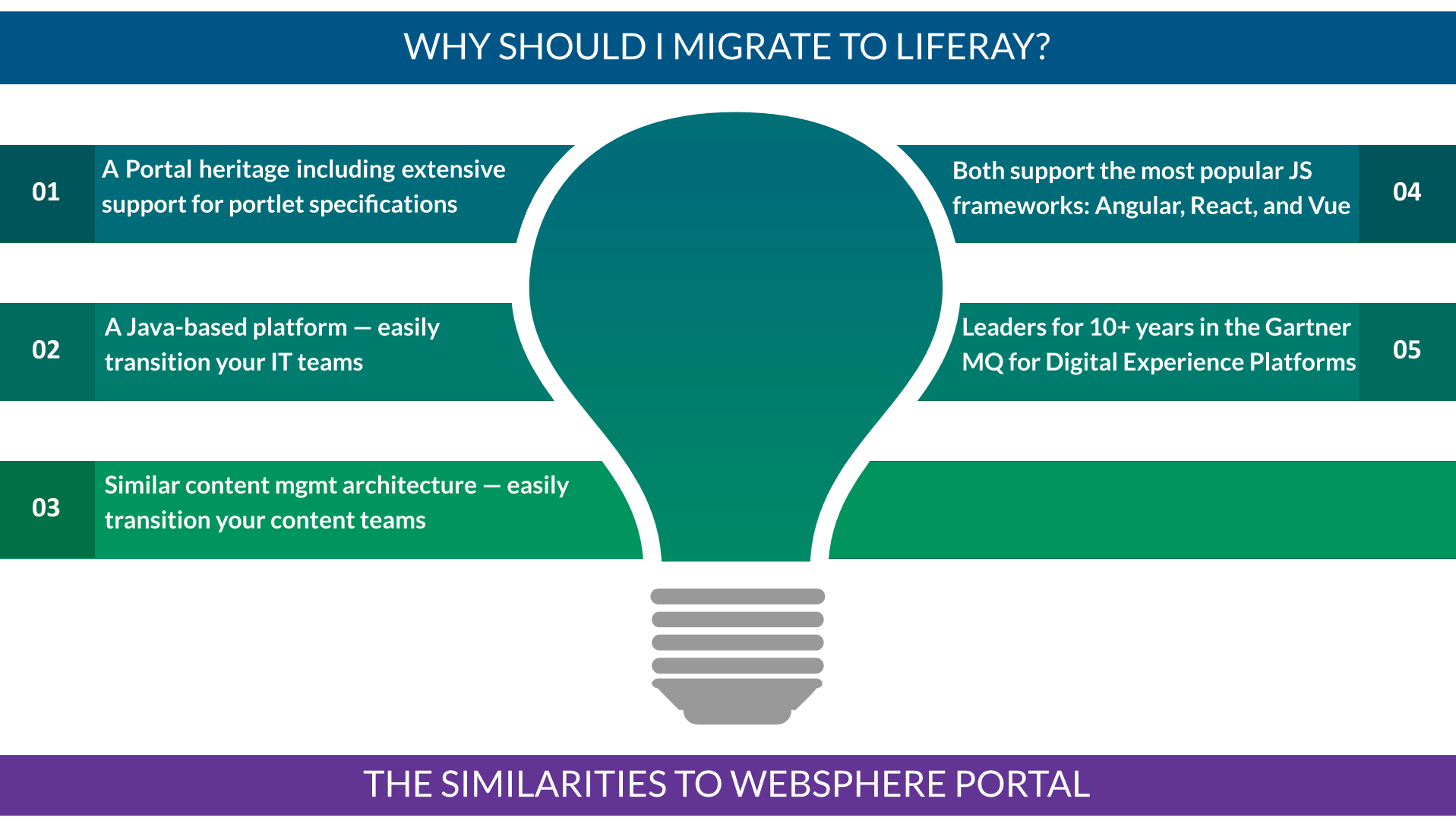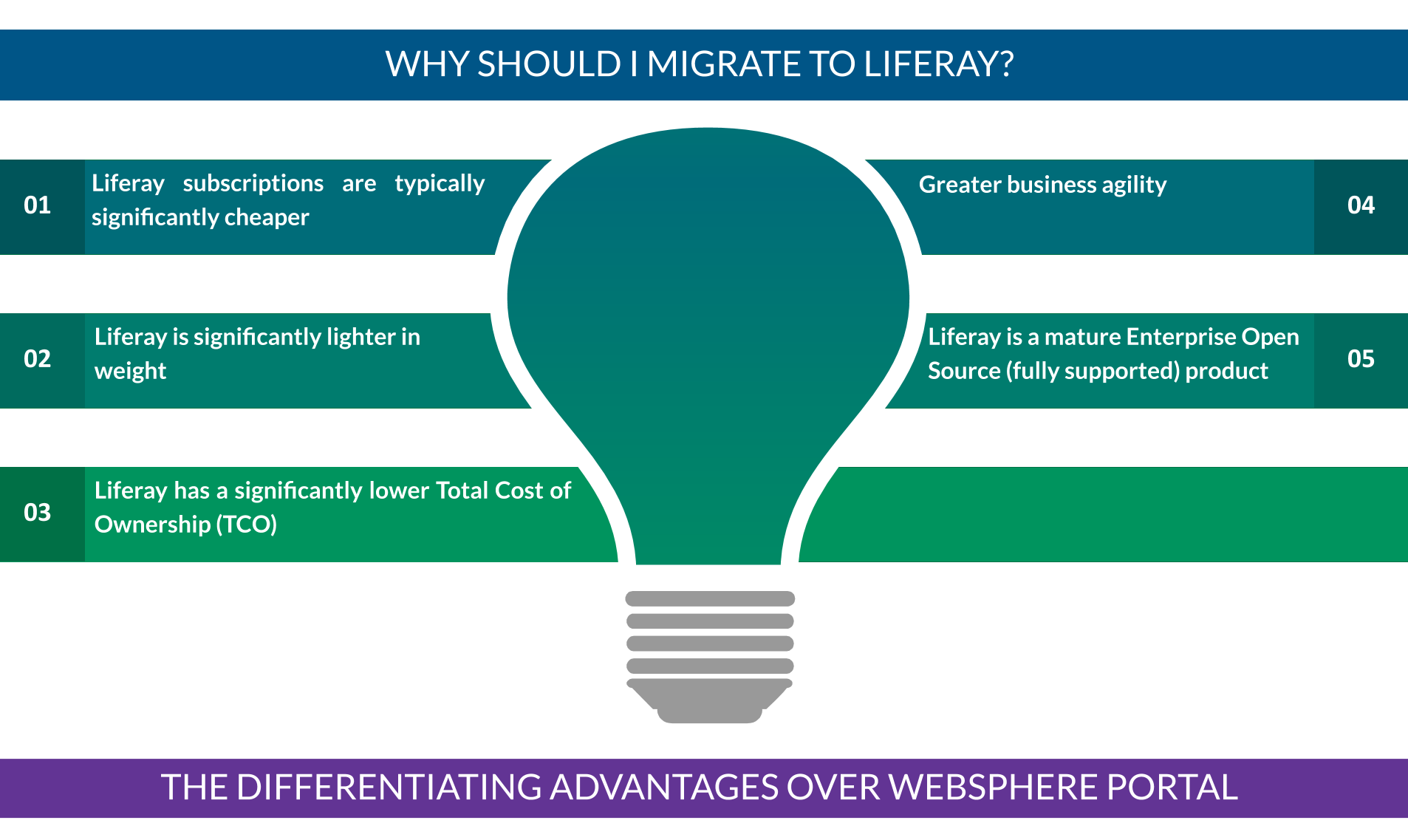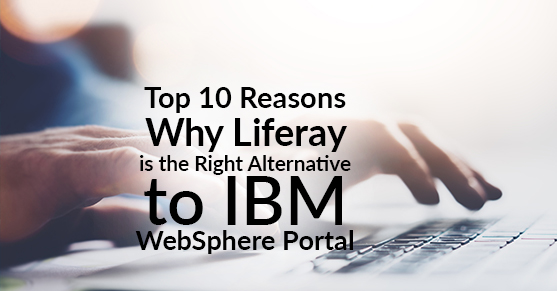This article is a follow-up to my earlier article on Why it is time to migrate from IBM WebSphere Portal, and is relevant for all members of the IBM WebSphere Portal product family, including IBM WebSphere Portal Server, IBM Digital Experience Manager, IBM Customer Experience Suite, IBM Web Content Manager, IBM WebSphere Portal Enable, IBM WebSphere Portal Extend, and IBM WebSphere Portal Express.
If you haven’t already read my earlier article Why it is time to migrate from IBM WebSphere Portal, and you are not convinced that you should migrate away from WebSphere Portal, then you should check out that article. That article also gives you a little bit of my personal background and that of XTIVIA. We’ve been delivering enterprise portal, content management, collaboration, personalization, and application solutions to customers since the late 1990s, and for many years worked with WebSphere Portal as our preferred portal platform, before we transitioned to Liferay as our recommendation in the early 2010s.
So, while you might say I have somewhat colored lenses, I do have a strong background in the IBM WebSphere Portal family of products as well as Liferay. With that disclaimer out of the way, let me dive into the heart of my article.
 If you are currently delivering your digital experiences through WebSphere Portal (or a product from this family) and looking for alternatives to get off this dying platform, then look no further than Liferay DXP, a modern, vibrant product that shares the same Portal heritage and similar content management architecture, while having key differentiators such as lower TCO, greater agility, enterprise open source roots and more.
If you are currently delivering your digital experiences through WebSphere Portal (or a product from this family) and looking for alternatives to get off this dying platform, then look no further than Liferay DXP, a modern, vibrant product that shares the same Portal heritage and similar content management architecture, while having key differentiators such as lower TCO, greater agility, enterprise open source roots and more.The rest of my article expands on the rationale behind my assertion, first focusing on five similarities between WebSphere Portal and Liferay, and then discussing five of Liferay’s differentiating advantages, making for a total of ten reasons why Liferay is the right alternative platform for IBM WebSphere Portal.
Top 5 Similarities That Make Liferay the Right Alternative to WebSphere Portal
Liferay and the IBM WebSphere Portal of products share a number of key similarities that ease migrating your WebSphere Portal implementation over to Liferay.
- Liferay has a Portal heritage similar to WebSphere Portal, including extensive support for portlet specifications — standard JSR168 and JSR286 portlets, Spring MVC portlets, Struts portlets, and JSF portlets. This means that if you have an investment in WebSphere Portal and portlets, then the adherence to the portlet specification will ease the migration to Liferay DXP, one of the few portal heritage Digital Experience Platforms that are still vibrant, and the only one that is a leader in the 2020 Gartner Magic Quadrant for Digital Experience Platforms.
- Liferay is a Java-based platform similar to WebSphere Portal, which leads to many similarities in terms of development approaches, deployment and programming models, and operational support and system administration needs. This enables you to easily transition your IT teams from WebSphere Portal to Liferay.
- Both Liferay and IBM Web Content Manager (WCM) share many similarities when it comes to web content management. For example, authoring templates in WCM map to Liferay web content structures and presentation templates in WCM map to web content templates. These and other similarities make it easier on the content management team to transition over to Liferay.
- Liferay, like WebSphere Portal, supports modern JavaScript applications built using the most popular JavaScript platforms: Angular, React, and Vue. If you invested in JavaScript Single Page Apps (SPA) using the IBM Script Portlet, then Liferay offers a path for you to migrate your investment in these JavaScript SPAs over to Liferay using the JS Generator toolkit.
- Both Liferay and IBM WebSphere Portal have been Leaders for 10+ years in the Gartner Magic Quadrant for Digital Experience Platforms (and previously horizontal portals).

Figure 1: Top 5 Similarities That Make Liferay the Right Alternative to WebSphere Portal
Top 5 Differences That Make Liferay the Right Alternative to WebSphere Portal
Liferay also offers a number of differentiating advantages over IBM WebSphere Portal (and other Digital Experience Platform products), and I have chosen to highlight five of those advantages here.
- Liferay subscriptions are typically significantly cheaper than IBM WebSphere Portal (and now HCL DX) licensing and maintenance — the same is true compared to other key Digital Experience Platform competitors (including Adobe, Oracle, and many others).
- Liferay is significantly lighter in weight compared to IBM WebSphere Portal (and HCL DX). Downloading it and getting it running takes a matter of minutes. Starting up Liferay is faster. Developing and testing custom apps on Liferay is faster.
- Liferay has a significantly lower Total Cost of Ownership (TCO) than IBM WebSphere Portal and other top DXP competitors. Not only are the subscription costs lower, but the savings continue through development costs, operational costs, and training/support costs (from the perspective of infrastructure, developers, administrators, and end users).
- Greater business agility: it is lightweight in nature, enabling you to get it running and configured quickly; its ease of use and management enable your IT and business users to configure, tailor, and develop custom functionality on Liferay to meet your business objectives.
- Liferay is a mature Enterprise Open Source (fully supported) product versus WebSphere Portal, which is closed source and difficult to extend and customize. Just like WebSphere Portal, Liferay offers a variety of support options, including 24x7x365 platinum support with 1 hour response time SLA; this includes access to all service packs, hot fixes, notifications of security alerts, phone, and web-based support.

Figure 2: Top 5 Differences That Make Liferay the Right Alternative to WebSphere Portal
While these did not make my top five list, I also want to call out a few other characteristics of Liferay that help it stand out against its competitors.
- Liferay DXP is a cohesive product through organic innovation. Even when Liferay added Liferay Commerce and Liferay Analytics Cloud as standalone products that complement DXP, they were built from the ground up to be seamless with the base DXP product. This is important when you consider the hodge-podge of acquired products that characterize some of Liferay’s competitors).
- Liferay DXP is a single platform that seamlessly supports the entire customer journey and is ready for your enterprise-grade Digital Initiatives — this is good for your customers and for your internal teams that support them.
- Liferay offers streamlined platform implementations and migrations — all Digital Experience Platform products typically need extensions and/or additions to deliver requisite functionality — with Liferay you can simply do more within a specific budget.
- Liferay offers significant flexibility — in terms of development approaches, deployment models and technology stacks (operating system, database, application server, and more), integration options, security architecture, and much more.
In Closing: Liferay is the Right Alternative to WebSphere Portal
As I wrote in my earlier article, it is high time for you to get off a dying platform in WebSphere Portal. And as articulated above, in our opinion and based on our first-hand experience migrating customers from IBM Websphere Portal to Liferay DXP, Liferay DXP is the best choice for you, given its similarities to WebSphere Portal that ease your migration journey, and its plentiful differentiating advantages.
A Recent XTIVIA and Liferay Success Story
We worked with a health insurer with 1.5 million members to successfully migrate them off an aging IBM WebSphere Portal platform to Liferay DXP.
Some highlights:
This insurer had an extensive web implementation
- A total of 18 sites including logged-in functionality for members, providers, brokers, employers and internal associates
- 100+ portlets
- Extensive usage of
- Content management and personalization
- Integration with multiple back-end systems and databases
- SSO integration with multiple external providers
- Complex access control requirements based on LDAP security groups
This migration was a resounding success
- Annual licensing cost savings
- A more modern, lightweight platform in Liferay that was easy to learn and adopt for the health insurer’s employees because of its similarities to IBM WebSphere Portal and IBM Web Content Manager
- A new and enhanced user experience for providers, employers, and brokers
- A more compact, cleaned-up code base (leading to greater agility).
The overall migration timeline from project inception till go-live was an impressive 18 months despite the scope of this effort.
If you are running any product from the IBM WebSphere Portal product family, then please reach out to us to discuss your potential alternatives, and have a no-obligation conversation about Liferay DXP and how we can help you successfully navigate a migration to a vibrant, growing platform in Liferay. The time to take action is NOW!

